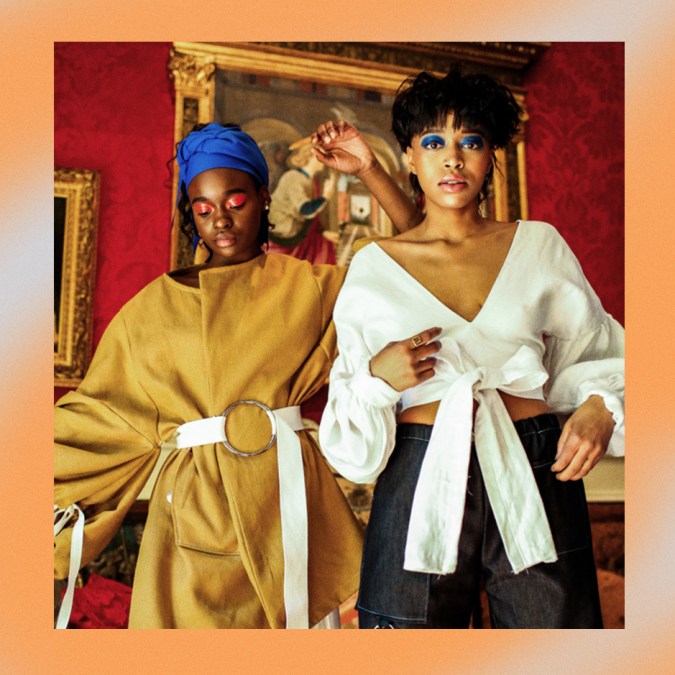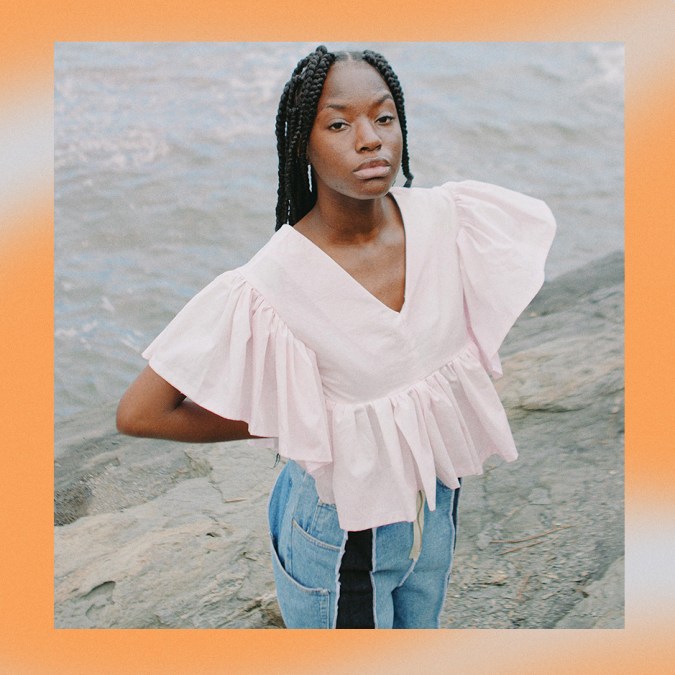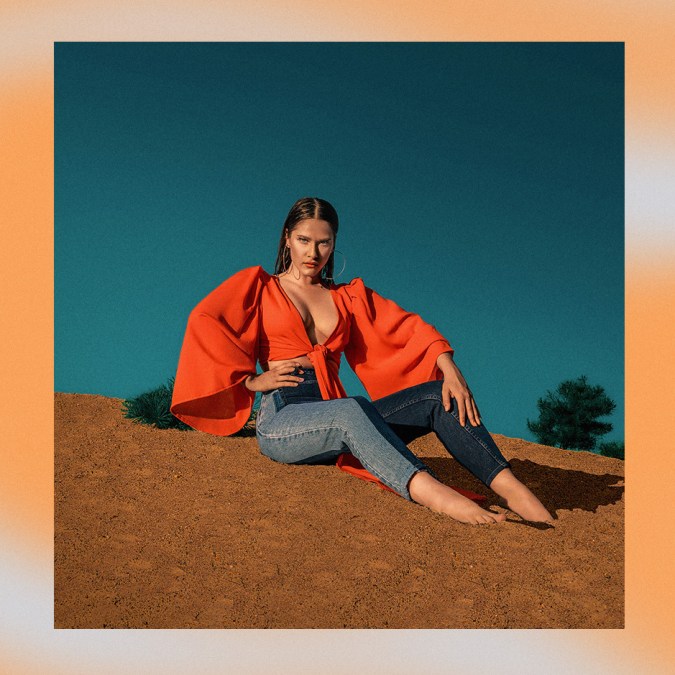While some of us spend endless time indoors and others brave the outdoors in masks, fashion has become a meaningless yet constant part of our lives. Whether you’re joyously wallowing in pajamas or daydreaming about re-presenting yourself once “things go back to normal,” clothing’s sway on how we feel moving through the world is ultimately undeniable.
Nathalia JMag is a designer and sustainable living advocate who is intimately aware of both fashion’s potential to empower and its steep human and environmental cost. Her ethical fashion brilliantly interweaves reworked denim streetwear and voluminous romance in a way that eclipses the shapeless yet constricting $500 linen sack dresses and beige t-shirts that are conjured whenever someone mentions sustainable style.
“I make clothes for fashion-forward people who want to wear their values,” she tells Remezcla. “If you’re interested in sustainable fashion, but you don’t like typical sustainable fashion, then I am the designer for you.”
Born in Pereira, Colombia (Kali Uchis’ hometown), JMag emigrated to Framingham, Massachusetts when she was 7-years-old. Today, the Project Runway Season 15 participant is often mistaken for someone in her thirties because of how much she has accomplished with her brand thus far or they believe she’s younger because of her looks, she believes, but it may be due to her idealism and drive.

As fast fashion corporations co-opt social justice buzzwords while denying their workers a living wage, the 27-year-old stays running a genuinely ethical brand. She tells us how, why and more in this Creating in Crisis conversation.
This interview has been lightly edited and condensed for clarity purposes.

How does your story with fashion begin and was it always intertwined with sustainability?

My mom has been letting me dress myself since I was 3. I’d wear mismatched things… Whenever adults would make fun of me, my mom would respond, ‘She can wear whatever she wants.’ When I was a teenager, I was into alternative fashion and would get in trouble at school for showing too much skin, but my parents would tell me I looked great… They just let me express myself.
I never thought I could have a career in fashion until I was in college. I started a fashion blog my freshman year but still thought of it as a hobby. Then, after changing my major around five times, I finally switched to Fashion Design and stuck with it. From the start, I knew I wanted to start my own fashion company because I don’t want to go work for a fashion corporation… they’re exploiting people in the supply chain and ruining the environment. I had an epiphany where I realized that I’m going to be part of the solution. I didn’t know how at the time because I was learning about conventional fashion. I’d call out one of my professors when she would try to justify the unethical slave and child labor in the industry by saying workers were lucky they had jobs. Some older people in the fashion industry, like in other industries, think that these are the way things are, and we should just deal with it; but I say, ‘No. We’re here to make the world better.’
In my last semester of college, I took a Special Topics where I learned about zero-waste design and upcycling, so I started incorporating those into my designs. My first few collections weren’t that sustainable because I was just trying to find my voice. I’d go to the fabric store and pick out whatever I thought was cool, and then I learned that a lot of the fabrics I’d gravitate towards were really bad for the environment. I have also been a vegetarian, and now a vegan, for around 10 years, so I was using faux fur, which is good for animals but is very unsustainable. I kept picking up this knowledge as I went along and decided to get a Masters in Sustainability at the Rhode Island School of Design.

Sustainable fashion is on the rise, but there is this frustrating issue where Black, Brown, and Indigenous artisans who have maintained sustainable fashion through making their clothes by hand to this day aren’t given recognition for their work. How do you think that we can disrupt this understanding of sustainable fashion as something so linked to wealthy white women?
We need to decolonize sustainable fashion. White women have kind of taken it over, and many of the thought leaders in sustainable fashion are white women. Most people mean well, especially in the sustainability sphere and they understand we have racism and social problems too. But even bringing these issues up by saying something like, ‘Indigenous people invented sustainable fashion, and we need to give them credit,’ is really important. I also think we just need more brands that do that, and we just need more Black, Brown, and Indigenous voices in the movement.
It’s also so important to acknowledge that sustainable fashion is not just a trend. Like, I’m hyped that it’s a trend but it’s also being hi-jacked and greenwashed. Sustainability is almost losing its meaning because brands like Everlane, H&M, and Zara are saying, “Oh, we have a sustainable line.” But it really doesn’t matter if you’ve made 3 t-shirts from organic cotton because you’re still overproducing 7,000 designs a week, and that’s literally ruining the environment.
This column is about Creating in Crisis, and you created 2 collections in quarantine! That must have been very challenging because so much of fashion is about being able to go out and look cute, and putting on fashion shows. What was the biggest creative shift for you as a designer during quarantine?
For 2020 I had a lot of plans. I am an entrepreneur and I have different businesses. I have my fashion brand, Nathalia JMag, I have my second-hand store, The Maximal Minimalist, and I also have an event production business that’s attached to my brand. For example, I put on fashion shows, so I did one event in 2020 before quarantine.
I had to shift, so I looked at my plans for 2020 and saw I cant really have events, so that part of my business is on standby. I had to put my second-hand shop on hold as well because everything was closed, so I couldn’t go out to curate new items. Ultimately, I was spending all my time and energy on my brand, and I was making a lot of masks to donate and to sell. Then, I decided I wanted to make a new collection because only making masks would be boring. What are people buying right now? People aren’t buying dresses and coats. They’re buying stuff to be at home. I just wanted to make easy, loungewear stuff, and that inspired Quarantina. I really love that exposed seam trend because it makes the garment more multidimensional where you can wear a garment in multiple ways, and people can’t tell if you wear the same thing three days in a row.

I designed my second collection, Quarantina 2.0, a couple of months ago when places were starting to open up again. I wanted to design this collection for people who want pieces they can look forward to wearing when quarantine is over, so Quarantina 2.0 is more for special occasions. I have one dress that’s super fancy, and I have a dress shirt that you can wear to go to work or to hang out with your friends if you’re trying to dress up.
What do you think are the biggest misconceptions about sustainability and sustainable fashion amongst Latines?
In general, the biggest misconceptions about sustainable fashion are that it’s always very expensive and that it looks crunchy. In Latin communities, those perceptions are there too, but we also think that ‘moda sostenible’ is stuff that only white people wear.
Overall, sustainable fashion can be classist and elitist because you need to have extra time on your hands to know, research and worry about it. If you’re concerned about the most basic things in Maslow’s hierarchy of needs, like paying rent and buying food, you’re not going to care that your shirt is from Forever 21. There are a lot of barriers to entry.
Of course, there are plenty of very wealthy Latines, but I do think that we are less wasteful generally because a lot of us are immigrants. I remember when my family first arrived here from Colombia, and, at one point, 10 of us lived in one 2-bedroom apartment. All of our furniture was stuff that people had tossed on the street. We would go to the dollar store; we wouldn’t waste food; we would save containers to store things instead of buying tupperware. People with low-incomes are also inherently more sustainable because they have to be, not by choice but by doing things like eating less meat. It’s really messed up when the sustainability movement shames poor people. Because this is my career, I wonder, how can we educate people who wouldn’t learn about environmentalism otherwise? I also want people to know that a lot of cheaper items are not only toxic for the environment but also for your health.
What are your goals for growth when not trying to grow too much inherently as a sustainability advocate who doesn’t want to overproduce but also wanting to expand as a creator of a brand?
One thing I learned at RISD, which was kind of discouraging, is that you can’t truly have a 100% sustainable brand in a global economy, but you have to focus on what’s most important and go from there.
If I get 200 orders a month, there’s no way I can make everything myself. I would have to hire a whole team of seamstresses if we were going to stay on a made-to-order model. I don’t ever want to have the problem of having excess stuff. I already get stressed out for all the inventory I have for my second-hand stuff. Thankfully I sell 95% of the things I source for my second-hand shop and I wear the rest myself.
If I am being 100% honest my goal is to just be the CEO of my company. I would want to have a marketing and social media department as well as a production manager. I want to create a company so that I can hire people, and I would specifically want to hire immigrants.

Do you have advice for young Latinx designers?
Don’t be afraid to channel your culture. When I started designing, I didn’t use anything that was too ‘Latina.’ I didn’t use yellow or red on purpose because they’re big Colombian colors. I didn’t want people to think I was just another Latina designer that’s using flounces and little frills and making red dresses. In a way, I was the one stereotyping Latina designers,but I think I unlearned a lot of that because it was just me being self-consciously racist to my own culture. I definitely embrace it now and am very inspired by traditional Colombian clothing like the clothes that palanqueras wear. I love color, and I love creating things that look super flared and Latin but in a fresh way that anyone could wear.
My other advice to young designers is don’t give up. Anyone can become a fashion designer—even if you don’t know how to sew or draw. You can learn. You have to try to stand out and put out as much work as possible. When you first start creating and sewing, your first are not going to be that cute. Get that out of the way, and just keep at it. Also, you can message me if you want any advice because I love mentoring people.




